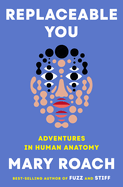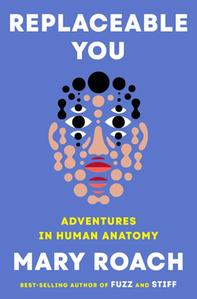
 With books like Gulp: Adventures on the Alimentary Canal and Bonk: The Curious Coupling of Science and Sex, Mary Roach has earned a well-deserved reputation for delivering useful scientific information to a general readership with impressive style and wit. Replaceable You: Adventures in Human Anatomy, a lively survey of the state of the art in the field of regenerative medicine--a collection of disciplines that, in the aggregate, function as the equivalent of a human auto body shop--continues on that same path.
With books like Gulp: Adventures on the Alimentary Canal and Bonk: The Curious Coupling of Science and Sex, Mary Roach has earned a well-deserved reputation for delivering useful scientific information to a general readership with impressive style and wit. Replaceable You: Adventures in Human Anatomy, a lively survey of the state of the art in the field of regenerative medicine--a collection of disciplines that, in the aggregate, function as the equivalent of a human auto body shop--continues on that same path.
Each of Replaceable You's chapters focuses on a discrete body part or system, such as hair follicles and the rectum. With Roach as an inquisitive, intelligent guide, readers learn about mundane topics, like the evolution of the technology for joint replacements, alongside exotic research into editing pig genes to reduce the probability that their organs will be rejected when implanted in humans, and more. That problem, as Roach explains in her chapter on hair replacement, is what drives the search for "stealth" cells--"a line of iPS [induced pluripotent stem] cells that are able to dodge the human immune system, making immunosuppression unnecessary," something she calls the "Holy Grail of regenerative medicine."
In describing efforts like these, Roach isn't afraid to step out from behind her computer and observe cutting-edge research and practice up close. Among other places, her travels took her to Sichuan, China, where researchers are working to overcome traditional Chinese reluctance to donate organs by exploring ways of adapting pig organs to human beings, and to a clinic in Tbilisi, Georgia, attempting to track down a doctor who uses fingers for penis transplants.
Roach also engaged in participatory journalism, as she trained in the critical skill of intubation with a group of medical residents at Stanford and even spent some time inside one of the last working Emerson ventilators--better known as an iron lung--to experience what it felt like to have it breathe for her. She caps off the book with a visit to a Pittsburgh organ procurement organization where she observed a tissue harvesting session.
In the chapter on fashioning a vagina out of a colon, Roach comments on the "remarkable and sometimes surreal adaptability-- the agreeableness--of the human body." That characterization provides a touchstone for many of the examples she discusses in her intriguing book. But as she cautions in her chapter on 3D printed organs, citing Carnegie Mellon biomedical engineer Adam Feinberg, when it comes to implanting entire functional bioprinted organs in patients, we are "somewhere around the Wright brothers stage." Despite that caveat, anyone interested in an informative, entertaining exploration of the fast-moving developments in these fields will enjoy taking that trip with Mary Roach. --Harvey Freedenberg, freelance reviewer
Shelf Talker: In a survey of the history and state of the art of regenerative medicine, Mary Roach leads readers on a fascinating journey through the science of replacing failing and failed human body parts.

